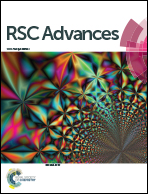Solubility study of tobramycin in room temperature ionic liquids: an experimental and computational based study†
Abstract
Herein, we present a computational and experimental study assessing the solubility of tobramycin 1 in a series of hydrophilic room temperature ionic liquids (RTIL). We show that hydrophilic ionic liquids, in particular those containing acetate, [OAc]−, enable significantly enhanced solubilisation of tobramycin in comparison to conventional molecular solvents.


 Please wait while we load your content...
Please wait while we load your content...